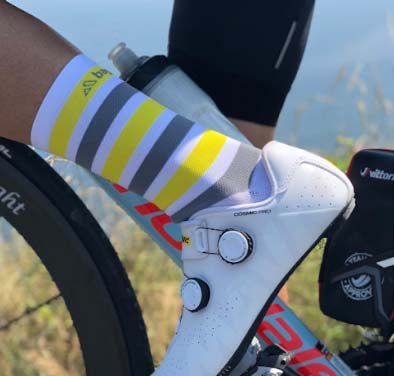#54 Mechanical doping, present and future
One of the first professionals to speak out on this issue was former Italian cyclist Davide Cassani , who was commentating on the Giro stages for Italian television in 2010. In a video report, he showed a bicycle with a small hidden motor and claimed that this type of practice was taking place in professional cycling and that with such a machine he himself "could win Giro stages at the age of 50."
He didn't bring up the subject by chance. That year, Fabian Cancellara shocked the world with the ease with which he swept past his rivals in the Tour of Flanders and Paris-Roubaix, sparking all sorts of comments and suspicions.
[caption id="attachment_4331" align="aligncenter" width="1024"]  Source: eltiempo.es[/caption]
In 2014, Canadian Ryder Hesjedal crashed on the seventh day of the Vuelta a España, and his bicycle wheel, which was lying on the ground, continued to spin suspiciously, raising many eyebrows.
https://www.youtube.com/watch?v=QFNMjAfjJw4
And to this day, there are numerous videos on the Internet in which fans seem to find evidence of this type of doping in all kinds of competitions.
Source: eltiempo.es[/caption]
In 2014, Canadian Ryder Hesjedal crashed on the seventh day of the Vuelta a España, and his bicycle wheel, which was lying on the ground, continued to spin suspiciously, raising many eyebrows.
https://www.youtube.com/watch?v=QFNMjAfjJw4
And to this day, there are numerous videos on the Internet in which fans seem to find evidence of this type of doping in all kinds of competitions.



 It is rumored that starting this year, new devices will be implemented using radiation and heat technology that will help detect possible alterations in the components of competitors' bicycles.
We'll be keeping an eye on these developments. In the meantime, if you want to enjoy an accessory that will make your life easier and that isn't (and never will be) banned by the UCI, get your Baggicase now, the waterproof case specially designed for cyclists, where you can store your cell phone, keys, and other personal items. Baggicase fits all current cell phone brands and sizes and can be customized with any color you like.
It is rumored that starting this year, new devices will be implemented using radiation and heat technology that will help detect possible alterations in the components of competitors' bicycles.
We'll be keeping an eye on these developments. In the meantime, if you want to enjoy an accessory that will make your life easier and that isn't (and never will be) banned by the UCI, get your Baggicase now, the waterproof case specially designed for cyclists, where you can store your cell phone, keys, and other personal items. Baggicase fits all current cell phone brands and sizes and can be customized with any color you like.
 Source: eltiempo.es[/caption]
In 2014, Canadian Ryder Hesjedal crashed on the seventh day of the Vuelta a España, and his bicycle wheel, which was lying on the ground, continued to spin suspiciously, raising many eyebrows.
https://www.youtube.com/watch?v=QFNMjAfjJw4
And to this day, there are numerous videos on the Internet in which fans seem to find evidence of this type of doping in all kinds of competitions.
Source: eltiempo.es[/caption]
In 2014, Canadian Ryder Hesjedal crashed on the seventh day of the Vuelta a España, and his bicycle wheel, which was lying on the ground, continued to spin suspiciously, raising many eyebrows.
https://www.youtube.com/watch?v=QFNMjAfjJw4
And to this day, there are numerous videos on the Internet in which fans seem to find evidence of this type of doping in all kinds of competitions.
The first sanctioned
It was all rumors and speculation until finally, what had to happen happened: someone was caught red-handed. Femke Van den Driessche , a 19-year-old cyclocross racer, will forever be remembered as the first cyclist to be penalized for fraudulently modifying her bike. Suspicious wiring set off alarm bells, and it was eventually confirmed that her bike did indeed have a small motor hidden in the bottom bracket. This happened during the U23 World Championships, held in Zolder, Belgium, in February 2016 . The punishment was swift and, as expected, intended to be exemplary: a six-year suspension (from 2015 to 2021), a fine of 20,000 Swiss francs (€18,200), plus court costs, and the return of her Belgian and European championship medals. The young woman always maintained that it wasn't her fault, but eventually retired from professional sports. This type of doping has even been detected in amateur cycling. In October 2017, a cyclist was arrested after a third-category race in Saint-Michel de Double , in southwestern France, because he didn't even bother to hide it. His effortless ramping aroused the suspicions of the French anti-doping agency.

The eternal suspicion
Since Van den Driessche 's sanction, what had been a fairly intense rumor has become a constant state of suspicion, with fans from all over the world constantly uploading videos trying to unmask alleged cheaters. If Contador changed wheels during the Aprica stage of the 2015 Giro d'Italia, where Basso lent him his wheel so the rider wouldn't lose time, L'Equipe newspaper started spreading rumors that something was fishy, without really having a solid basis. Immediately afterward, the UCI unexpectedly scanned the bikes of Contador , Hesjedal (the usual suspect), Gilbert , Nocentini , and Elissonde, but found nothing amiss. On the other hand, a few weeks ago, the French journalist Philippe Brunel published the book " Rouler plus vite que la mort " (Running faster than death), in which he argues that the pioneer in using this type of cheating is none other than Lance Armstrong , who had already lost the seven Tour de France he had won between 1999 and 2005 due to doping with EPO and testosterone. Brunel expressly accuses Istvan Varjas , a Hungarian engineer, of being the person who provided Armstrong with this type of technology in 1998. The American cyclist denies everything and says that these accusations are practically a joke. According to this book by Philippe Brunel , the motors invented by Istvan are completely silent and invisible because they are mounted inside the seat post or wheel axles. They can be manually activated using a remote control and even synchronized with the heart rate monitor, activating when a certain heart rate level is reached.The future of technological doping
Claudio Ghisalberti , a cycling and technology expert, wrote about this topic in La Gazzetta Dello Sport when the Belgian cyclist's case broke: In this article, Ghisalberti argues that: “The motor hidden in the frame is outdated, almost artisanal. It's outdated. It's the doping of the poor. The new frontier is much more technologically advanced and also much more expensive. It's in the rear wheel, costs 200,000 euros, and there's a six-month waiting list to get one.” This new system "generates less power than the poorer system, but is preferred by professionals" because it is virtually undetectable. The manufacturer's name is not mentioned, but it seems that orders keep coming in. And there's more. According to Ghisalberti himself, wheels with electromagnetic technology are already being developed that could provide extra assistance to cyclists without the UCI even suspecting anything. These wheels are capable of electromagnetically generating 20 to 60 watts of power, enough to make the difference at the key moment of a stage. The attached graphic is the one published by Gazzeta dello Sport in 2016, which shows how this electromagnetic system is hidden in a high-profile carbon wheel.
How does the UCI intend to combat doping?
Until now, the UCI has been implementing the same measures it implemented in 2013, which involved randomly selecting riders or teams and scanning their bikes with portable scanners . In the case of the Tour de France, this monitoring was carried out at every stage. This scanning method was considered more effective than X-rays, thermal imaging, or ultrasound, but the UCI wants to go even further. UCI President David Lappartien stated in a press conference on January 29 that he has "huge concerns" about the potential use of motors in cycling. That's why he has hired Jean-Christophe Péraud , a former professional road and mountain cyclist, as the new person in charge of combating technological fraud. It seems we'll have to wait a few more days to see how this system of controls is implemented, since, according to Lappartient: "We'll announce new developments in the second half of March ." It is rumored that starting this year, new devices will be implemented using radiation and heat technology that will help detect possible alterations in the components of competitors' bicycles.
We'll be keeping an eye on these developments. In the meantime, if you want to enjoy an accessory that will make your life easier and that isn't (and never will be) banned by the UCI, get your Baggicase now, the waterproof case specially designed for cyclists, where you can store your cell phone, keys, and other personal items. Baggicase fits all current cell phone brands and sizes and can be customized with any color you like.
It is rumored that starting this year, new devices will be implemented using radiation and heat technology that will help detect possible alterations in the components of competitors' bicycles.
We'll be keeping an eye on these developments. In the meantime, if you want to enjoy an accessory that will make your life easier and that isn't (and never will be) banned by the UCI, get your Baggicase now, the waterproof case specially designed for cyclists, where you can store your cell phone, keys, and other personal items. Baggicase fits all current cell phone brands and sizes and can be customized with any color you like.

